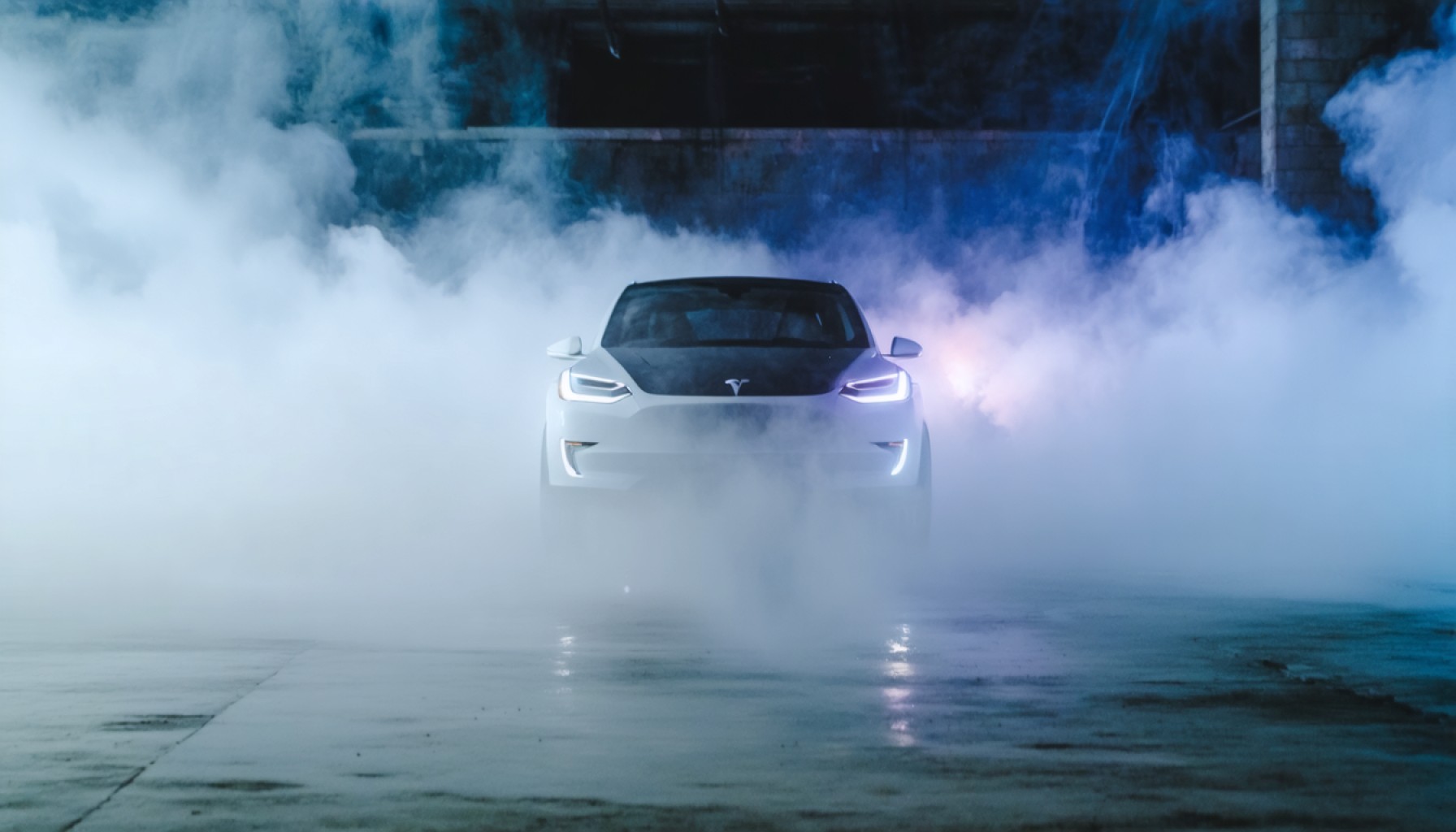- Tesla’s dominance in the electric vehicle market is waning due to increased competition and leadership controversies.
- Global vehicle deliveries plateaued, with 1.79 million vehicles delivered in 2024, indicating possible stagnation.
- Facing strong competition, particularly from BYD in China, Tesla’s European sales have also dramatically declined, with a 76% drop in Germany.
- Elon Musk’s political involvements may be impacting consumer perceptions and sales negatively.
- Internal issues reflect divided focus among Musk’s ventures, affecting strategic direction and investor confidence.
- Tesla’s energy division shows promise, with significant revenue and deployment growth, but remains a small part of its business.
- As Tesla navigates its current challenges, its future hinges on balancing visionary goals with market realities.
Tesla, once the unchallenged titan of electric vehicles, is finding itself at a crossroads that few could have predicted a few years ago. For many, it represented not just a car company but a vision of the future—a clean, smart, and electric world. The brand gleamed under the leadership of Elon Musk, who inspired both adoration and intense scrutiny. Yet, recent developments suggest that the luster has dulled, as competitive pressures and leadership controversies threaten to reshape Tesla’s narrative.
The meteoric rise of Tesla’s stock price, fueled by Musk’s charisma and the allure of cutting-edge innovation, now appears misaligned with its underlying fundamentals. Tesla’s global vehicle deliveries have begun to plateau, signaling a potentially troubling trend. The company delivered 1.79 million vehicles in 2024, marking a slight decline from the previous year. The once-sluggish competitors have not only caught up but are racing ahead, as seen with BYD’s technological advances in ultra-fast charging and their surging market share in China—a market Tesla recently had dominion over.
Tesla’s once unassailable dominance in Europe has crumbled. Sales have plummeted across key European markets, with a staggering 76% drop in Germany alone in February, even as the broader European EV market grew. Intriguingly, Elon Musk’s growing political entanglements may have sowed seeds of discord among consumers, resonating through decreased sales figures and rising public dissent.
Across the Pacific, the Chinese market—the electric vehicle industry’s most fiercely contested battleground—presents its own hurdles. Despite a record year for Tesla in 2024, a 15% sales dip in January 2025 underscores a shifting tide. Domestic titan BYD has emerged not just as a formidable competitor—it’s now an industry leader, eclipsing Tesla’s sales with innovations that redefine consumer expectations.
Internally, Tesla’s challenges are exacerbated by issues of brand perception and strategic focus. Musk’s attention is divided among a constellation of ventures, from the Department of Government Efficiency to SpaceX. This diversification of focus is increasingly seen as a detriment to Tesla’s core mission as some of its venerated champions in the investment world, like Cathie Wood and Ron Baron, re-evaluate their commitments to the company.
As competitors seize upon Tesla’s vulnerabilities, protestors and perplexed consumers alike voice their concerns—some openly protesting, others quietly choosing different brands. The resale market swells with used Teslas, hinting at a growing discontent among erstwhile devotees who question not just the brand’s reputation but also its safety.
Nevertheless, in the midst of tumult, Tesla finds hope in its energy division—marking a 67% growth in revenue in 2024, with energy storage deployments soaring to 31 GWh, a 114% increase year-over-year. This part of the business is a beacon of innovation and potential, yet, in the grand scheme, it only constitutes a fraction of Tesla’s operations, which are overwhelmingly vehicle-centric.
Tesla’s narrative, once a heroic tale of growth and innovation, now faces trials that suggest deep introspection is needed. Its valuation, still towering above peers despite recent declines, assumes a future that seems increasingly speculative. How Tesla navigates this pivotal moment, balancing between the realities of its current fundamentals and the visionary dreams it continues to sell, will determine whether it can recapture its status as an industry paragon or fade into the annals of history as a tale of disrupted potential.
Is Tesla Losing Its Grip on the Electric Vehicle Market?
Introduction
Tesla, once synonymous with electric vehicle success and innovation, now stands at a critical juncture. While the company still holds immense brand value and technological prowess, recent developments suggest a shift that could redefine its trajectory. As Tesla grapples with increased competition, leadership controversies, and changing market dynamics, it’s vital to delve deeper into these concerns and explore a range of related topics.
Competitor Advances and Market Dynamics
1. Rise of Global Competitors:
– BYD’s Dominance: BYD’s rapid growth in the electric vehicle sector, especially in China, positions it as a formidable competitor. BYD’s advances in ultra-fast charging technologies and production efficiencies have allowed it to capture significant market share, surpassing Tesla’s sales figures in its home market (Source: Financial Times).
– European Market Shifts: Tesla’s market share in Europe is declining, with Germany witnessing a drastic 76% drop in Tesla sales in February 2024. Tesla’s struggles are contrasted by increasing adoption of European-manufactured EVs, which often align more closely with local tax incentives and consumer preferences (Source: Bloomberg).
2. Leadership and Strategic Focus:
– Elon Musk’s Diversified Interests: Musk’s involvement in various ventures, from SpaceX to social media, may dilute his attention from Tesla’s core operations, affecting strategic decision-making and investor confidence.
– Controversial Stances: Political statements and actions by Musk have led to polarizing views among consumers, impacting brand perception and sales in specific regions (Source: Wall Street Journal).
Tesla’s Internal and External Challenges
1. Brand Perception and Customer Sentiment:
– Protests and Resale Market: The resale market seeing an uptick in used Teslas suggests growing consumer discontent. Concerns about safety features and build quality are echoed in these market trends, alongside protests from environmental groups and former loyalists.
2. Financial and Operational Metrics:
– Sales and Deliveries: While 2024 saw Tesla deliver 1.79 million vehicles globally, a decline from the previous year signals potential concern if this trend continues amidst rising operational costs and intensified competition.
– Energy Division as a Beacon: Tesla’s energy division, despite contributing a smaller portion of overall revenue, shows robust growth, with a 67% increase and energy storage deployments surging to 31 GWh. This division captures Tesla’s innovation spirit and could prove pivotal in future diversification strategies.
Insights and Predictions
1. Industry Trends:
– Electrification and Sustainability: The global push toward sustainable energy sources and transportation solutions aligns with Tesla’s long-term mission. As governments worldwide tighten emissions regulations, electric vehicle adoption will continue.
– Technology and Infrastructure: Advances in battery technology and charging infrastructure will play integral roles in determining market leaders.
2. Market Forecast:
– Tesla’s Positioning: Tesla’s ability to adapt to changing market dynamics, particularly in the Chinese and European markets, will determine its future. How effectively Tesla harnesses its technological innovations across all sectors, not just vehicles, will be critical.
Actionable Recommendations
For Tesla:
– Refocused Leadership: Ensuring dedicated leadership for Tesla to maintain its innovative edge in the automotive and energy sectors.
– Consumer Engagement: Addressing consumer feedback proactively to rebuild and strengthen brand loyalty.
For Consumers:
– Research and Evaluation: When considering an electric vehicle purchase, assess factors such as value proposition, aftersales support, and financial incentives in your region.
Conclusion
Tesla stands at a pivotal moment, balancing its innovative legacy with the realities of an evolving market. The company’s ability to navigate these challenges will not only define its future but also shape the broader narrative of electric vehicle adoption across the globe.
For more insights into the automotive industry’s future, visit Tesla’s website.









